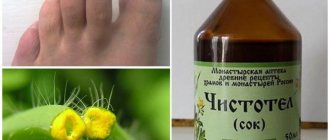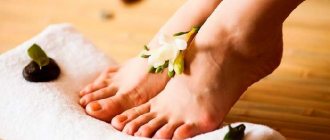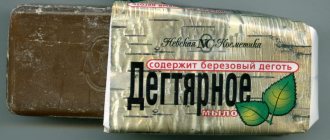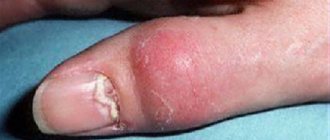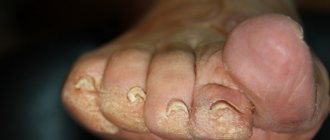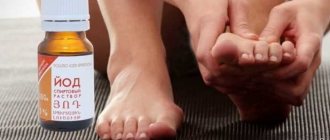Quick navigation
- Pharmacology of the drug
- Is Iodinol harmful?
- Indications for use
- Contraindications for use
- Mode of application
- Adverse Effects
- Reviews from patients and doctors
The drug Iodinol is often used in folk medicine against nail fungus. At the same time, experts say that this drug is universal - not only as an antifungal agent, but also for the treatment of skin and internal diseases.
100 ml of Iodinol contain 0.3 g of potassium iodide, 0.1 g of iodine and 0.9 g of polyvinyl alcohol. Sold in dark glass bottles in modest cardboard packaging.
Pharmacology of the drug
Why is Iodinol useful for fungus? Reviews say that it is able to exhibit a pronounced antiseptic effect, thanks to iodine molecules in the active ingredients.
During the treatment of skin and nails, the resorptive effect of iodine appears almost immediately. This element significantly improves metabolism, produces a proteolytic effect, accelerates dissimilation processes, and also takes an active part in the synthesis of the hormones T3 and T4.
Due to the content of polyvinyl alcohol, the removal of iodine from the human body is noticeably slower, and its irritating effect is also reduced.
Iodinol destroys pathogenic species of fungi and yeast, and also has a negative effect on spores of anthrax pathogens.
It should also be noted that the drug is active against streptococci, gram-positive flora, protease, most gram-negative bacteria and E. coli.
After using the solution, a pronounced bactericidal effect appears.
pharmachologic effect
Iodinol is an affordable and at the same time effective remedy, which, unlike many analogues and traditional methods, can remove even old particles of mycospores. The drug destroys pathogenic yeast-like microflora even in advanced stages of onychomycosis.
Iodinol has the following medicinal properties:
- antifungal;
- antiseptic;
- bactericidal;
- regenerating.
With the help of polyvinyl alcohol, the effectiveness of the drug is prolonged. The slow breakdown of the active ingredients makes it gentle on nails and skin and does not cause irritation.
Active substances penetrate directly into the cell membrane of onychomycosis pathogens, destroying protein fractions. Microorganisms die, their growth and development are disrupted.
Indications for use
Local use of Iodinol is indicated not only for fungus on the nails, but also for trophic and varicose ulcers, thermal and chemical burns (grade 1-2), atrophic rhinitis, chronic tonsillitis and purulent otitis media.
In gynecological practice, the use of this product is limited to an antiseptic effect on the surface where surgery is planned.
As for infectious inflammatory skin lesions, myalgia and various injuries, in this case the drug is prescribed externally.
It should also be noted that the drug in question can be taken orally. As a rule, for the treatment of tertiary syphilis or atherosclerosis.
How to use
The instructions for using Iodinol for nail fungus are quite multifaceted. There are several ways to cure a fungal disease with this medication:
- Lotion.
- Lubrication.
- Baths.
- Preparation of ointment.
Lotions
This method of use for treating fungus is the most common. It will require the Iodinol solution itself, a cotton pad or piece of cotton wool, cling film and a regular plaster for fixation. Cotton wool is soaked in the medicine and applied over the affected nail. Everything is wrapped together in film or, if there is none, then in a plastic bag. This compress is fixed on the finger with an adhesive plaster for several hours. After removing the lotion, you need to wash off everything that remains and apply a nourishing cream around the nail.
Important!
The treatment time in this way should not exceed 5 days in a row! After five days, you should take a break and moisten the applied cotton wool with vegetable oil. It is healthier if the oil is olive.
If the fungus is not started, then within the specified period the nail will come off and a new healthy plate will begin to grow.
Mode of application
Do not forget that treatment of nail fungus should be done after consulting a doctor. However, there is nothing complicated in using this product - apply Iodinol 2-4 times a day to the nail plates, no bandage is required.
To irrigate the nasopharynx, the medicine is used 2-3 times a week for three months. For instillation or ear washing, the solution is used for four weeks.
For burns and surgical practice, moisten gauze pads with Iodinol and apply them to the affected area.
If the medicine must be taken orally, the dosage is determined individually by the doctor (depending on the age and indications of the patient).
What's in it
Iodinol is produced in the form of a dark blue solution. The smell is very similar to iodine. It dissolves well in water and easily forms foam. If used externally, it is almost completely safe.
Consists of three components:
- Molecular iodine. Causes the protein contained in the body of the fungus to fold. Conducts disinfection in the area where it is distributed and destroys pathogenic microorganisms. A sign of recovery will be a renewed nail plate, without any damage or signs of fungus.
- Potassium Iodide. This component has a disinfecting effect on the nail and saturates it with potassium.
- Polyvinyl alcohol. Reduces the irritation effect of the active component. The substance slows down the breakdown of iodine, which exposes the treated epidermis to longer exposure to the medicinal solution.
Iodinol treatment of toenail fungus is carried out by softening the horny structure of the nail. This makes it easier to remove a plate that is affected by a fungal infection.
Iodinol is a Russian-made product. On pharmacy shelves it is presented in dark glass bottles of 50, 100, 330 ml and in spray. There are also bottles equipped with a spray nozzle.
Reviews from patients and doctors
Experts say the medicine is not officially intended to treat fungal infections of the nail plates. But despite this, many patients use Iodinol for these purposes.
According to them, the drug has a pronounced anti-inflammatory and antiseptic effect. As a result, fungal infections are quickly eliminated. Although not every patient can boast of this. For some, Iodinol did not help at all with fungus.
Read: Foot fungus. Photo of the disease and treatment with drugs that are inexpensive but effective
Undesirable effects
If you use Iodinol for more than 5 days, a condition called iodism occurs and is characterized by an oversaturation of the body with iodine. This condition is manifested by the following symptoms:
- Feeling weak.
- Skin rash.
- Muscle spasm (cramp).
- Malaise.
Whether it is possible to carry out repeated courses of therapy in this case must be decided together with your attending physician and not earlier than after a few days of break. Too frequent or prolonged use may result in chemical burns.
Important!
It is strictly forbidden to mix the product with hydrogen peroxide or other disinfectants. This may increase the irritant effect on the skin.
Can Iodinol be used during pregnancy?
Considering the special effect of the drug on a woman’s body during pregnancy and on the child in the womb, the drug is not prescribed during this important period. Externally, Iodinol can be prescribed by the attending physician, weighing the importance and benefit for the mother and the danger to the fetus.
It is worth noting that in small doses, the drug entering a woman’s body during lactation can stimulate milk production, but if the dose is increased, the effect may be the opposite - lactation is suppressed.
Do not forget about the ability of iodine to enhance the dissimilation process. By suppressing the concentration of beta-lipoproteins and cholesterol, the lipoproteinase and fibronolytic activity of the blood serum increases, which is fraught with bleeding due to a decrease in blood clotting.
If iodine deficiency is not observed in the body of a pregnant woman, under the influence of the drug, iodides can inhibit the production of thyroid hormones, which reduces the sensitivity of the thyroid gland.
According to the instructions, women are prohibited from using Iodinol during pregnancy and breastfeeding.
Analogs
The closest composition to Iodinol is the usual 5% alcohol solution of iodine. It also has a proven antifungal effect. But it acts more aggressively on nails and skin, so it is recommended for the treatment and prevention of mycotic infections much less frequently.
Any antiseptics containing iodine are considered as substitutes for Iodinol. This list includes the drugs listed in the table.
| Name | Description |
| IODONATE | Antiseptic and disinfectant drug. It has antimicrobial activity, including against onychomycosis pathogens. Available in 1 liter orange bottles. The cost in Russia is from 54 rubles, in Ukraine from 16 hryvnia. |
| SODIUM IODIDE | Prescribed for mycotic infections due to its pronounced antiseptic effect. The drug is available in the form of a powder, highly soluble in water and alcohol. The product is sold in packages of 5 g. In Russia, its cost is from 30 rubles, in Ukraine - from 6 hryvnia. |
| LUGOL'S SOLUTION | It has antiseptic, fungicidal and anti-inflammatory properties. For nail fungus it is used topically. The cost in Russia starts from 78 rubles per 25 ml bottle, in Ukraine - from 5.7 hryvnia. |
If it is necessary to select an analogue of Iodinol, self-medication should be avoided. All drug substitutes contain iodine as an active ingredient, which, if used uncontrolled, results in disruption of the thyroid gland.
Contraindications and side effects
Iodinol is prohibited for external use in the following cases:
- children under 5 years of age;
- pregnancy and lactation;
- individual hypersensitivity to iodine;
- pathology of the thyroid gland.
Doctors insist that for nail fungus, the drug cannot be used for therapeutic or prophylactic purposes for more than 5 days (an exception may be combined prescriptions with additional medications). Otherwise, the body is oversaturated with iodine compounds, iodism is formed, which negatively affects the functioning of the thyroid gland.
Side effects of the drug include:
- general weakness;
- rashes on the skin;
- disturbance of well-being;
- convulsive syndrome.
A repeated course of treatment with Iodinol can be carried out only if the treatment regimen is agreed upon with a specialist. There should be a pause of several days between its use.
